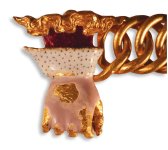Texas Jay
Bronze Member
- Feb 11, 2006
- 1,149
- 1,356
- Detector(s) used
- Garrett AT Pro, Garrett Scorpion Gold Stinger, Garrett Ace 350, Garrett Ace 250, vintage D-Tex SK 70, Tesoro Mojave, Dowsing Rods
- Primary Interest:
- All Treasure Hunting
A double humiliation for high-and-mighty archaeologists who missed this beautiful, valuable, historical treasure!
 Now, you know why archaeologists are always trying to discredit and demonize treasure hunters. We've proven that we're much better at finding treasure and recovering history than they are!
Now, you know why archaeologists are always trying to discredit and demonize treasure hunters. We've proven that we're much better at finding treasure and recovering history than they are!
"The find was announced by the British Museum as part of the launch for the Treasure Annual Report for 2020 and the Portable Antiquities Scheme Annual Report for 2021. These show that 45,581 archaeological finds -- including more than 1,000 treasure cases -- were recorded in 2021, 96% of which had been found by people metal-detecting."
~Texas Jay
https://www.cnn.com/style/article/amateur-detectorist-tudor-pendant-scli-intl-scn/index.html


"The find was announced by the British Museum as part of the launch for the Treasure Annual Report for 2020 and the Portable Antiquities Scheme Annual Report for 2021. These show that 45,581 archaeological finds -- including more than 1,000 treasure cases -- were recorded in 2021, 96% of which had been found by people metal-detecting."
~Texas Jay
https://www.cnn.com/style/article/amateur-detectorist-tudor-pendant-scli-intl-scn/index.html





